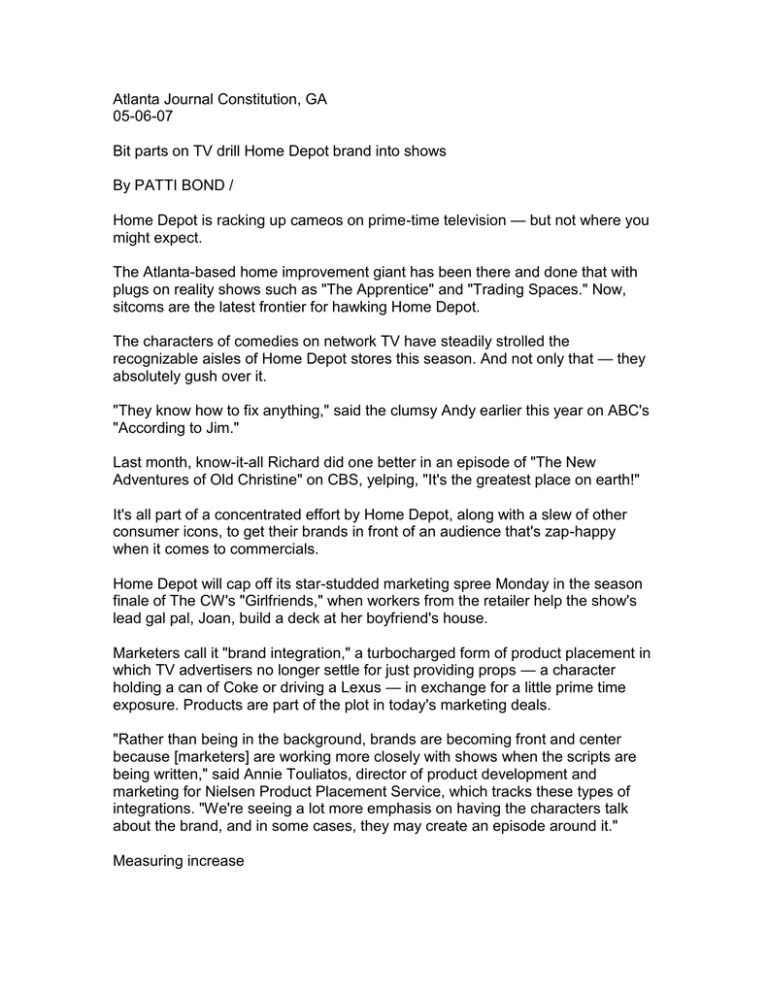Atlanta Journal Constitution, GA 05-06-07
advertisement

Atlanta Journal Constitution, GA 05-06-07 Bit parts on TV drill Home Depot brand into shows By PATTI BOND / Home Depot is racking up cameos on prime-time television — but not where you might expect. The Atlanta-based home improvement giant has been there and done that with plugs on reality shows such as "The Apprentice" and "Trading Spaces." Now, sitcoms are the latest frontier for hawking Home Depot. The characters of comedies on network TV have steadily strolled the recognizable aisles of Home Depot stores this season. And not only that — they absolutely gush over it. "They know how to fix anything," said the clumsy Andy earlier this year on ABC's "According to Jim." Last month, know-it-all Richard did one better in an episode of "The New Adventures of Old Christine" on CBS, yelping, "It's the greatest place on earth!" It's all part of a concentrated effort by Home Depot, along with a slew of other consumer icons, to get their brands in front of an audience that's zap-happy when it comes to commercials. Home Depot will cap off its star-studded marketing spree Monday in the season finale of The CW's "Girlfriends," when workers from the retailer help the show's lead gal pal, Joan, build a deck at her boyfriend's house. Marketers call it "brand integration," a turbocharged form of product placement in which TV advertisers no longer settle for just providing props — a character holding a can of Coke or driving a Lexus — in exchange for a little prime time exposure. Products are part of the plot in today's marketing deals. "Rather than being in the background, brands are becoming front and center because [marketers] are working more closely with shows when the scripts are being written," said Annie Touliatos, director of product development and marketing for Nielsen Product Placement Service, which tracks these types of integrations. "We're seeing a lot more emphasis on having the characters talk about the brand, and in some cases, they may create an episode around it." Measuring increase The number of scripted integrations, in which a character chats up a specific product or brand, rose 10 percent in 2006 to nearly 5,000 occurrences, according to Nielsen. Experts say it will keep growing as cash-crunched networks huddle with advertisers to scratch each other's backs. For Home Depot, getting a spot in sitcoms represents a chance to reach a new consumer group as it battles fast-growing Lowe's. Both retailers are active on cable TV, and Lowe's recently landed its first sitcom cameo on "The King of Queens" on CBS. Home Depot is looking to boost its exposure with female consumers, said Roger Adams, the company's senior vice president and chief marketing officer. "We love our integrations on [reality] shows on The Learning Channel, Discovery and other channels, but people expect us there," Adams said. "We're trying to hit a group of people who aren't our core do-it-yourselfers, who may not be as familiar with us." Home Depot has been a recurring guest on "Girlfriends," landing three major appearances, which is substantial, ad experts say, in an arena that primarily revolves around one-shot deals. Home Depot landed on "Girlfriends" after it worked with a consultant to boost its market share among black consumers. Its first appearance, last season, involved three female characters who went to a workshop at Home Depot to learn how to use power tools. "The show is very popular with African-Americans, plus it's all about empowered women," Adams said. "We wanted to feature how we empower women, and [the producers] liked the fact that we have 'do-it-herself' clinics at our store, so they built a show around it." The retailer's cameos were expanded this season as two "Girlfriends" characters tried to outdo the neighbors at Christmas by buying a boatload of lights and skiing polar bears from the neighborhood Home Depot. On Monday's finale, Home Depot workers will be on hand to help with a house renovation as lovestruck Joan waits for a marriage proposal from her new homeowner boyfriend. On the recent "New Adventures of Old Christine," starring Julia Louis-Dreyfus of "Seinfeld" fame, Home Depot worked its way into three scenes as the characters shopped and hung out in the kitchen decor department to joke about love and marriage. The storyline involved Richard, the contractor ex-husband of Christine, and his attempts to show Matthew, his goofy former brother-in-law, that Home Depot is the ultimate candy store for guy stuff. No luck — Matthew gets hung up on pretty plants and a telescoping light bulb changer that he later uses to pluck drinks from the fridge. "The way they portrayed us in 'Christine' makes us seem very approachable, and that was great for us," Adams said. "Part of the objective is to get beyond just the facts of our business because we have a very high awareness. ... A lot of people know we sell hardware and tools, but we want them to see us as being more relative in their everyday lifestyle." Matching products, shows The move toward scripted placements has created a cottage industry in Hollywood, where dozens of companies have sprung up to match TV advertisers with networks and producers. Unlike traditional product placement, under which companies provided goods at no cost in exchange for the exposure, TV advertisers will shell out big bucks to get worked into the storyline. There's no standard arrangement for the deals. Networks may agree to throw in some mentions as part of the overall advertising buy, or companies may pay specifically for the placement. Home Depot didn't pay for its first appearance on "Girlfriends," Adams said, but it has paid for all of its subsequent placements. "The cost varies but on average, it's roughly the same as a 30-second ad," he said. "It's a smart tactic, especially if [Home Depot] is trying to reach a new market because it's very difficult to communicate with new consumers," said product placement expert Jay Newell, a former marketer for Turner Broadcasting who now teaches advertising at Iowa State University. Despite an expected rise in spending for TV integrations, producers and advertisers alike claim they won't overdo it. Looking ahead There already has been a push-back among writers, who want more input on the deals — and a cut of the payments, too. In the meantime, Newell says the viewing public isn't protesting. "I have yet to find too much backlash at all. People seem to be willing to accept it with a wink. ... If anything, it's more noticeable now when you do see a generic product," Newell said. "My students will ask me why an actor is holding a can of pop instead of a Coke." Newell said he recently got a grant from a company called Delivery Agent to research the impact of TV integrations. The company already knows a bit about public interaction with product placements. It runs a Web site that sells products featured in sitcoms, dramas and reality shows. Do you like the Benjamin Moore paint color of Bree's impeccable dining room on "Desperate Housewives?" Or how about the Ugg boot worn by Meredith on last week's "Grey's Anatomy?" They're just a click away on SeenOn.com Direct product sales are the next step in product placement deals, marketing experts say. "There's a lot more of an effort to have some sort of call to action," Touliatos of Nielsen said. Next season, look for more of what's known as the "content wrap," a series of two-minute spots that offer products related to the TV shows. Characters from the shows may appear in the spots, which are produced with their own storylines, to chat up the products, she said. "It's like a commercial, but with a host."




